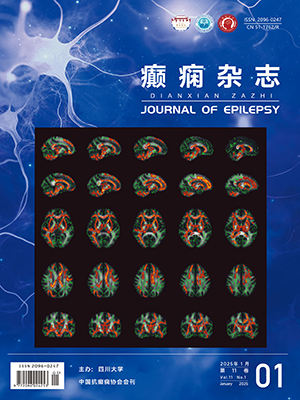| 1. |
齐旭红, 郭惠平, 温智勇, 等.脑灰质异位症的MRI诊断.脑与神经疾病杂志, 2011, 19(5): 355-358.
|
| 2. |
刘文钰, 安冬梅, 郝南亚, 等. 150例癫痫伴皮质发育不良患者的回顾性研究.癫痫杂志, 2016, 2(1): 14-17.
|
| 3. |
Sisodiya SM. Malformations of cortical development: burdens and insights from important causes of human epilepsy. Lancet Neurol, 2004, 3(1): 29-38.
|
| 4. |
Desikan RS, Barkovich AJ. Malformations of cortical development. Annneurol. 2016, 80(6): 797-810.
|
| 5. |
Pisano T, Barkovich AJ, Leventer RJ, et al.Peritrigonal and temporo-occipital heterotopia with corpus callosum and cerebellar dysgenesis. Neurology, 2012, 79(12): 1244-1251.
|
| 6. |
林绍鹏, 常好会, 刘晓蓉, 等.灰质异位症所致癫痫的临床表现与视频脑电图特征分析.中国全科医学, 2009, 12(24): 2204-2206.
|
| 7. |
Parrini E, Ramazzotti A, Dobyns WB, et al. Periventricular heterotopia: phenotypic heterogeneity and correlation with FilaminA mutations. Brain, 2006, 129(Pt 7): 1892-1906.
|
| 8. |
郑奎宏, 胡向红, 王克勤, 等.脑灰质异位症的MRI诊断(附18例分析).海军总医院学报, 2000, 13(1): 32-34.
|
| 9. |
孙红霞, 陶寻明.脑灰质异位症致难治性癫痫一例.中国社区医师, 2014, 30(19):132-133.
|
| 10. |
郝秀芹, 司传越, 张国先, 等.灰质异位症合并脑裂畸形一例.贵州医药, 2001, 25(10): 956.
|
| 11. |
张蕾莉, 崔世民, 刘梅丽, 等.脑灰质异位症的影像学诊断.中国医学影像技术, 2001, 17(03): 229-230.
|
| 12. |
祁俐, 李蕾, 赵奕楠, 等.灰质异位症的临床表现及影像学特点.中国实用医药, 2011, 6(10): 126.
|
| 13. |
Barkovich AJ, Guerrini R, Kuzniecky RI, et al.A developmental and genetic classification for malformations of cortical development: update 2012. Brain, 2012, 135(Pt 5): 1348-1369.
|
| 14. |
Srour M, Rioux MF, Varga C, et al. The clinical spectrum of nodular heterotopias in children: report of 31 patients. Epilepsia, 2011, 52(4): 728-737.
|
| 15. |
黄力, 王彤歌.大脑灰质异位症的MRI诊断(附2例家族性病例报告).现代医用影像学, 1996, 5(4): 157-159.
|
| 16. |
Lange M, Kasper B, Bohring A, et al. 47 patients with FLNA associated periventricular nodular heterotopia.Orphanet JRare Dis, 2015, 10:134-144.
|
| 17. |
Battaglia G, Chiapparini L, Franceschetti S, et al. Periventricular nodular heterotopia: classification, epileptic history, and genesis of epileptic discharges. Epilepsia, 2006, 47(1): 86-97.
|
| 18. |
范振, 魏祥品, 钱若兵, 等.电生理监测结合神经导航手术治疗灰质异位症所致癫痫.立体定向和功能性神经外科杂志, 2010, 23(2): 90-93.
|
| 19. |
薛汉忠, 张丽娟, 宁安.脑立体定向术治疗脑灰质异位症一例.武警医学, 2002, 13(10): 635.
|
| 20. |
Christodoulou JA, Walker LM, Del Tufo SN, et al. Abnormal structural and functional brain connectivity in gray matter heterotopia. Epilepsia, 2012, 53(6): 1024-1032.
|
| 21. |
Filippi CG, Maxwell AW, Watts R. Magnetic resonance diffusion tensor imaging metrics in perilesional white matter among children with periventricular nodular gray matter heterotopia. Pediatric radiology, 2013, 43(9): 1196-1203.
|
| 22. |
Tassi L, Colombo N, Cossu M, et al. Electroclinical, MRI and neuropathological study of 10 patients with nodular heterotopia, with surgical outcomes. Brain, 2005, 128(Pt 2): 321-337.
|
| 23. |
姚庆和, 张华, 高国栋.灰质异位症诊疗进展.立体定向和功能性神经外科杂志, 2008, 21(4): 247-249.
|




